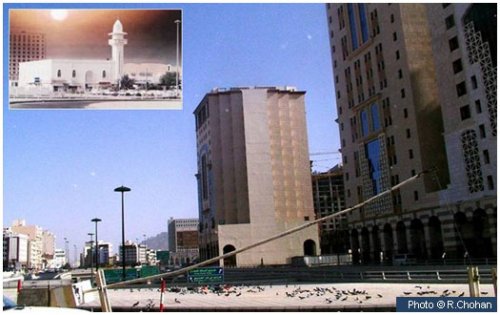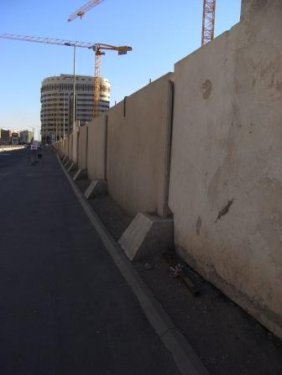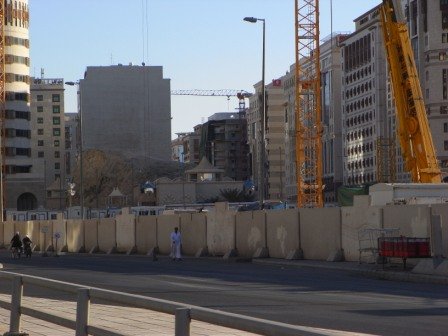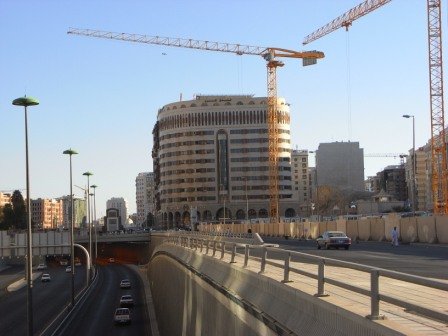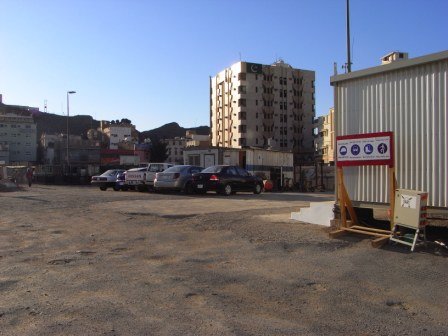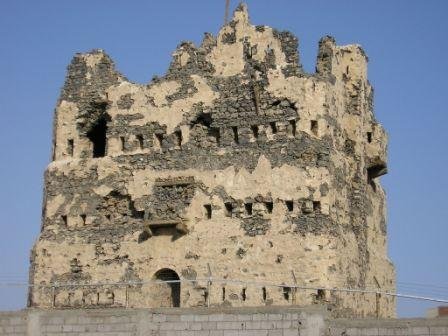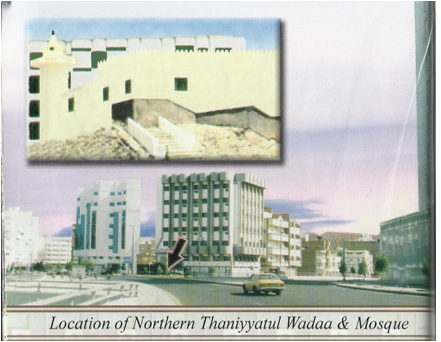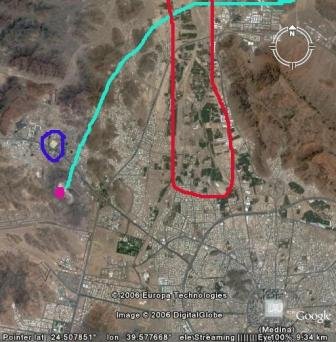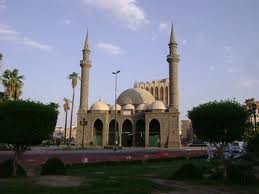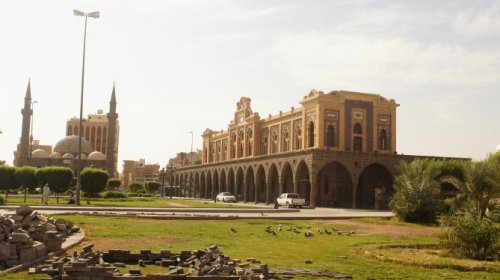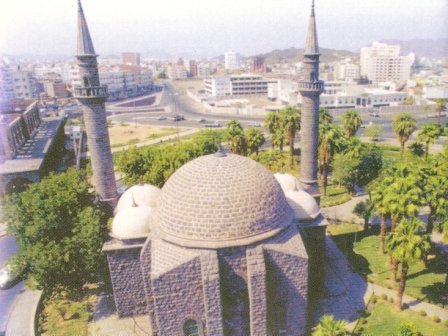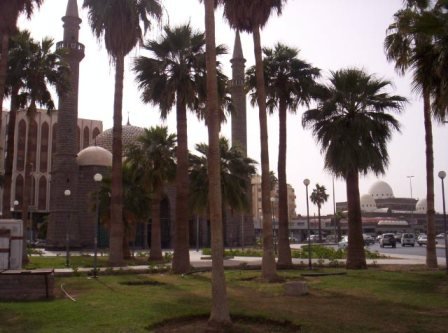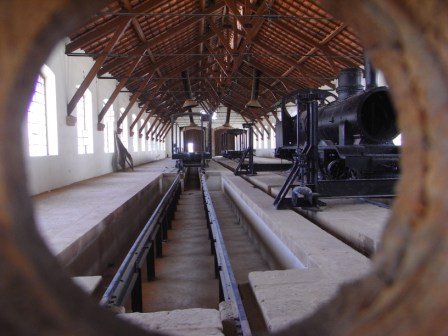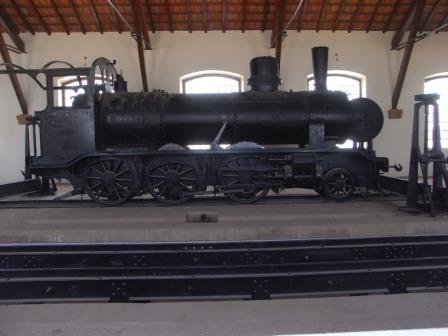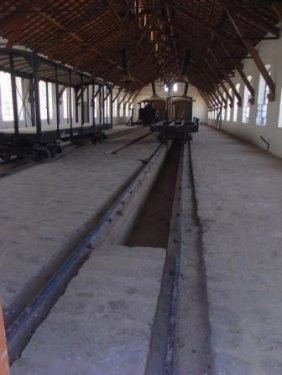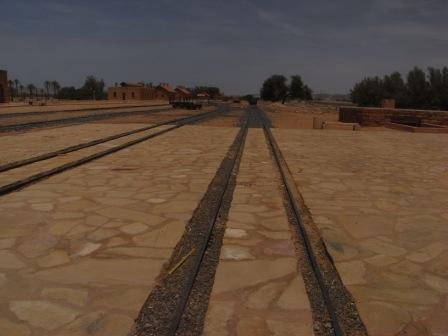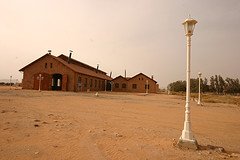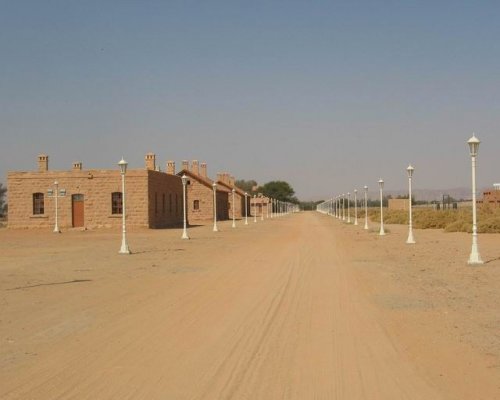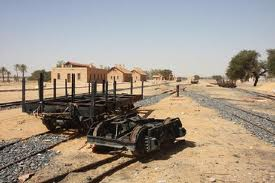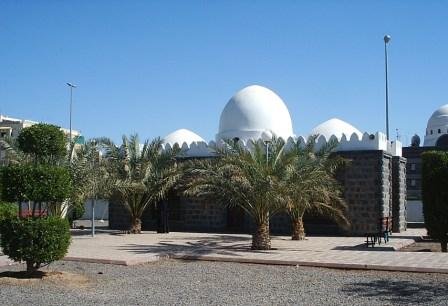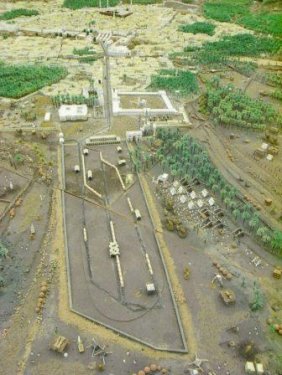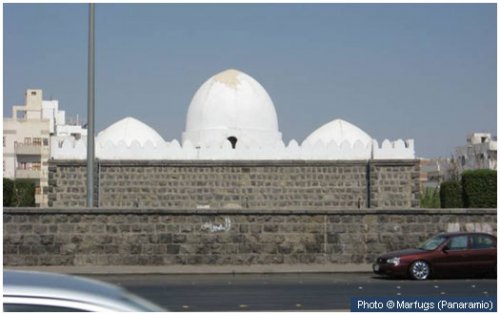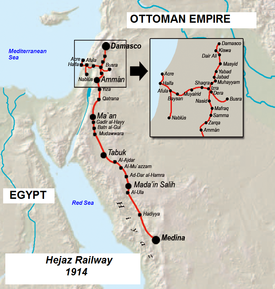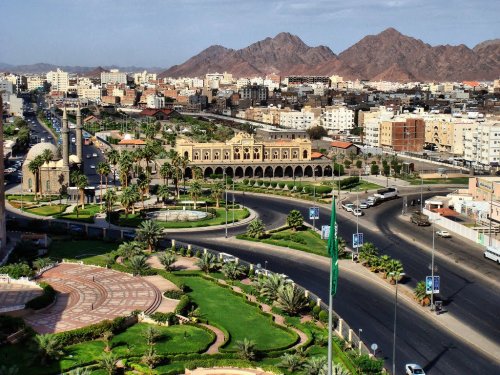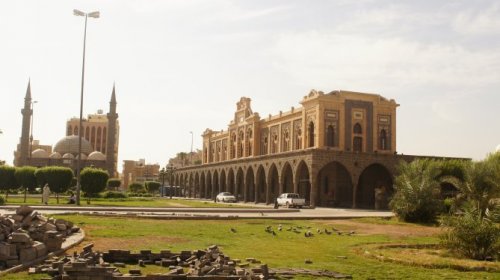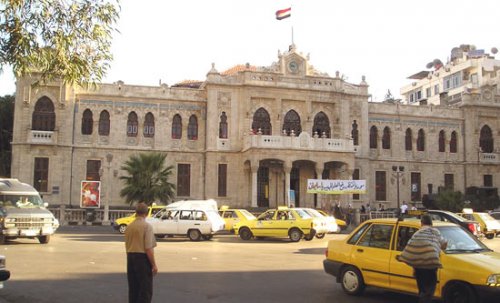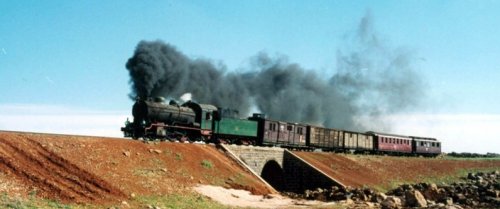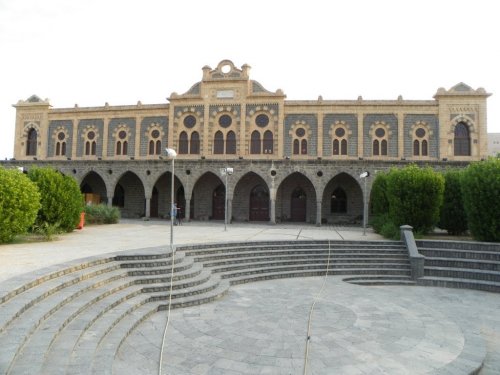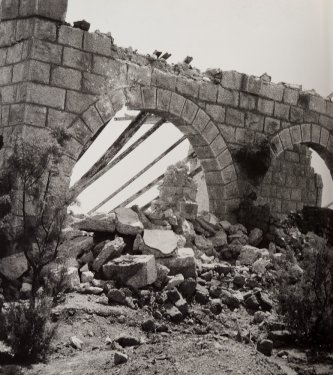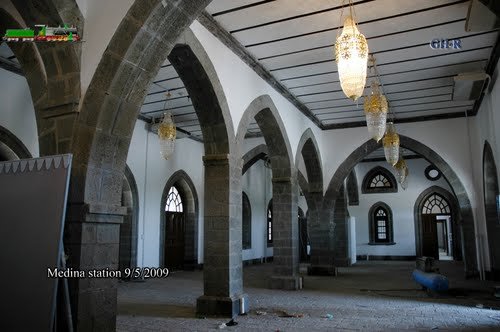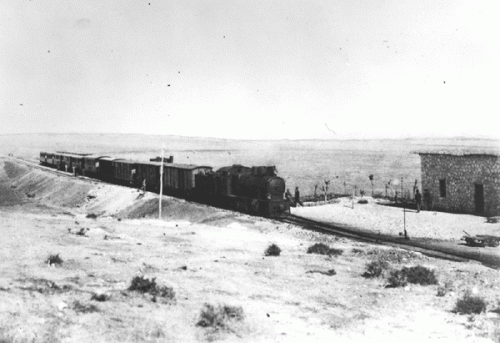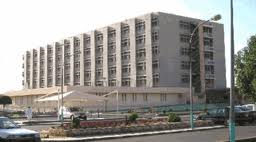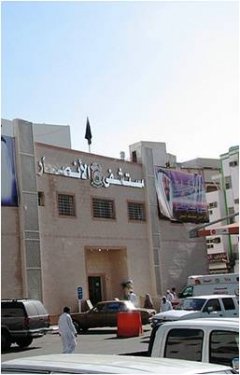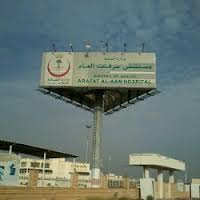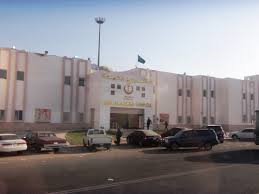-
Posts
8,434 -
Joined
-
Days Won
771
Content Type
Profiles
Forums
Events
Everything posted by ummtaalib
-
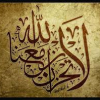
Tragedy Of The Leicester Fire Deaths
ummtaalib replied to ummtaalib's topic in General Islamic Discussions
Leicester Fire: Prayers Held For Victims An estimated 7,000 mourners gather for a prayer service for four family members who died in a blaze at their home. Thousands of mourners have attended a funeral prayer service for a mother and her three children who died in a suspected arson attack. An estimated 7,000 people gathered in Leicester's Spinney Hill Park to pay their respects to the memory of Shehnila Taufiq, 47, and her teenage children, daughter Zainab, and sons Bilal and Jamal. Mrs Taufiq's husband, Dr Muhammad Taufiq al Sattar, was among those who addressed the half-hour service, thanking mourners and police for their support Seven people have been charged with murdering the four family members, who died in the blaze at their home in the Spinney Hills area of Leicester on September 13. Speaking during the service, Dr Taufiq , who works in Dublin as a neurosurgeon, told mourners: "It's a sad day, my heart is crying. I would like to thank all of you for coming. "I know our hearts are breaking but all the brothers and sisters are with me, everybody from Leicester from all denominations, outside Leicester and throughout the world." The funeral prayers, taking place ahead of a burial service in Dublin at the weekend, were open to the public so that members of the local community could attend. Speaking to the media following the service, Dr Taufiq , whose wife and children were studying Islamic literature in Leicester, said the prayers had given him a sense of peace and tranquillity. The surgeon also said he had drawn strength from his religious faith since the fire, and was keen to continue to work for the benefit of the wider community in Ireland. Dr Taufiq told reporters: "I am not angry, yes my heart is broken. I cried a few times today carrying the coffins of my family (but) I am going to continue the work my wife and my children have left for me." Coffins of the four family members who died in the suspected arson attack As mourners gathered on a grass area in the park before the service, Chief Superintendent Rob Nixon, of Leicestershire Police, said: "It's good to see so many people wishing to pay their respects. "It's a tragic incident that has had a very significant impact on the local community." Source -
Question and Answer: Q. Is it preferable to do Qurbani locally or abroad, in countries like India, Palestine, etc.? A. Feeding the destitute and needy abroad is indeed meritorious. However, based on the fact that Rasulullah Sallallaahu alaihi wasallam advised his beloved daughter Faatimah Radhi-Allaahu anha to personally witness her Qurbani being carried out, it would be more virtuous to perform Qurbani locally. If an individual has surplus funds to purchase more than one share of Qurbani, then one can consider doing Nafl Qurbani abroad. (Jamiatul Ulama South Africa) And Allah Knows Best Fatwa Department Jamiatul Ulama (KZN) Council of Muslim Theologians
-
Better, Try to See the Light By Khalid Baig Modern day Christianity and Judaism have been through a series of "reformation" processes. Over the centuries tens of thousands of "reformed churches" and "reformed synagogues" have been established throughout Europe and America. Many see this revision and update as a continuous process. So, why not Islam? This question is a perplexing one for those looking at Islam from the outside. Unfortunately for many, it brings rage rather than reflection. Some are driven to do whatever it takes to make it happen. It is a measure of the intensity of such desire that, today, any ignoramus with a Muslim sounding name can become instant celebrity by declaring that Qur'an needs to be updated or Shariah needs to be rethought. In fact during the Satanic Verses affairs, when the entire Muslim world had been outraged by the support for pure filth shown by all sorts of pundits, many of these "experts" were secretly thrilled that the moment had arrived. A professor of Islamic Studies at the University of Southern California informed the Los Angeles Times readers at that time that the big question the Muslim world was debating was: "Who had really authored the Qur'an." Such psychotic scholarship has also been enlisted in all kinds of research projects as well as in secret plans by the U.N. and big powers to find ways of bringing "reform" to Islam. Some come disguised as friends. They appear to applaud Islam's teachings on tolerance and compassion. Islam does preach tolerance for those outside its boundaries. At the same time it is also very sensitive about its own boundaries and would not allow them to be blurred in a haze of tolerance. Some point to the principles of Ijtihad in Islam. But they fail to realize that Ijtihad does not mean second-guessing the Qur'an, Sunnah or consensus of the companions. Then there are those who resort to ridiculing Muslims for lagging behind the times. When all else fails, they may simply try to order an abrogation of Shariah, as the U.N. is trying to do now under the banner of the Universal Declaration of Human Rights. Wasted efforts, all! Their fight is with the Qur'an and they only need to turn to the Qur'an to get a response. Here it is, loud and clear: "But when Our clear revelations are recited unto them, they who look not for the meeting with Us, say: 'Bring us a Qur'an other than this, or change it.' Say (O Muhammad): It is not for me to change it of my own accord. I can only follow that which is revealed unto me. Lo! If I disobey my Lord I fear the retribution of an awful Day." [Yunus 10:15] If Qur'an could have been changed by worldly powers, it would have been changed long time ago. If it could be made controversial by secretly publishing and distributing corrupt versions, that would have been already done. But not an iota has changed in the Book that was revealed 1400 years ago. It is the only revealed book in the world that exists in the original language of its revelation. And if all the printed copies of it were to be destroyed today, the Book would remain for it is the only Book in the world that is memorized from cover to cover by millions upon millions of people. And it is the only revealed book that begins with this claim: "This is the Scripture whereof there is no doubt, a guidance unto those who ward off evil."[Albaqarah 2:2] There is no doubt that it is the Word of Allah. No doubt that it contains the ultimate truth. No doubt that it was sent through the last Messenger (Sall-Allahu alayhi wa sallam) of Allah who also explained what it means. No doubt that all success and happiness and bliss lies in faithfully following its commands and all failure and sorrow and misery lies in rejecting it. You either believe in this statement or you do not. There is no third option. A Muslim, by definition, is the person who attests to the truth of this statement. He has received Allah's Word through Allah's messenger, Sall-Allahu alayhi wa sallam, and he, by force of conviction, submits to this revealed truth. In fact, he stands as a witness to the mankind to the truth of this message. This witnessing is not meant to convert others, but only to deliver the Message, as a trust from Allah. The Message has been preserved precisely because no one is allowed to change it to make it attractive to the would be believers. Muslims do not do in Rome as the Romans do, because then they will have Islam no more. They rise above their surroundings by submitting to the Word of Allah and invite the whole world to the same. Those who accept it do it for their own good; those who reject it do so at their own peril. So, why is there no "reform" movement in Islam ala Christianity or Judaism? Because the latter lost their scriptures, Islam did not. Words of man replaced the words of God in their scriptures making the whole thing fallible. One can find hundreds of statements in the Bible that can be tested and found untrue. Or statements that contradict each other. There is not a single such instance in the Qur'an, and there will never be. Islam was never deformed that it should need reform. It is not dated that it should need to be updated. Its message is as true today as it was yesterday. All of its commands are as life giving today as they were yesterday and they will be tomorrow. It remains as the eternal beacon of light as humanity jumps from one extreme to the other in its ignorance. Right and wrong are eternal. Definitions of good and evil have to be constant. Otherwise, they will lose all meaning. In a world of shifting standards of good, there is no good. It is a great blessing for humanity that Islam provides that constant. If the entire world agrees that homosexuality is ok, Islam will still call it a great abomination. If the entire world agrees to destroy the institution of family, Islam will still be there to uphold it. If the entire world agrees that sickness is health and health is sickness, Islam will still be there to remove the confusion and safeguard health. You cannot ban light and legislate darkness. Better, try to see the light yourself. http://www.albalagh.net/food_for_thought/quran2.shtml
-
The Well of Zarwaan & the Black Magic of a Hypocrite In the post above (Horse Training Ground), mention is made of the locality of Banu Zuraiq (A prominent tribe of the Ansaar) which was situated to the south of Masjid Nabawi and Masjid Ghamamah and which was the finishing point of the shorter race course. The well of Zarwaan was also in the locality of the Banu Zuraiq. A hypocrite, Labeed bin al A'asam practiced magic over the Prophet sallallaahu 'alayhi wasallam and buried it in this well. Jibrail AS informed the Prophet sallallaahu 'alayhi wasallam of this and it was removed. Jibrail AS recited Suratul Falaq and Suratun Naas to cure him from the magic. (Sahih Bukhari Hadith number 5765) From "Pictorial History of Madinah Munawwarah" Dr.Muhammad Ilyas Abdul Ghani
-

Qurbaani When One Has Unsettled Debts
ummtaalib replied to MUSLIM WOMAN's topic in Hanafi Fiqh (General)
I found this paragraph quite simple to understand: It should be known that anyone who possesses a zakatable-minimum (nisab) the obligation to pay Zakat will commence. As soon as one possesses this amount, one’s Zakat year will start, and he will be obligated to actually pay Zakat once a whole year has passed if he still possesses an amount equal or more than the zakatable-minimum. The zakatable-minimum is equivalent to the value of 87 grams of gold. -

Qurbaani When One Has Unsettled Debts
ummtaalib replied to MUSLIM WOMAN's topic in Hanafi Fiqh (General)
wa'alaykumus salaam ww inshaAllah this Q/A will be of help: Q. When does zakat become obligatory upon a person and how would zakat be calculated? Answer Nisab means the minimum amount of wealth upon which Zakah is payable. It represents the guaranteed minimum financial floor above which an individual is deemed to be ‘Sahibe-Nisab’ (owner of wealth) and therefore liable to Zakah. The Nisab limit was set by the Prophet (SAW) at 20 mithqal of gold or 200 dirhams of silver (7.5 tolas of gold and 52.5 tolas of silver). These measures are equivalent to 87.48 grams of gold and 612.36 grams of silver respectively. If a person only has gold as an asset, then the Nisab measure for gold must be used. If however the person has a mixture of assets, then the Nisab level for silver should be used. To ascertain the current monetary equivalent of the Nisab limit, it is necessary to establish the market rate for a gram of gold and silver. This can be obtained from www.goldprice.org The current market rate (June 16th 2012) for a gram of gold is £33.26 and £0.59 for a gram of silver. Therefore the Nisab threshold for gold is approximately £2909.58 and for silver it is £361.29 (16/06/2012) A person will only pay Zakah when his Zakatable assets – after adding and subtracting debts owed either to or from others – is equal to, or in excess of £361.29 Source -
Horse Training Ground Masjid Sabaq Where the cars are parked in the second picture is where Masjid Sabaq was The location of Masjid Sabaq (which has been demolished) was 520 metres North-West of Masjid Nabawi. It used to be the ground used by the Prophet sallallaahu 'alayhi wasallam for training horses for the battles. Masjid Sabaq was just to the south of Thaniyyatul Wadaa (mentioned in the previous post) and was the starting point of a race course which the Prophet sallallaahu 'alayhi wasallam and his Companions Radhiyallaahu 'anhum used to train and race horses. The race course had two finishing points; The first finishing point was at the locality of Banu Zuraiq (A prominent tribe of the Ansaar) which was situated to the south of Masjid Nabawi and Masjid Ghamamah. This was the shorter course for untrained horses. The second finishing point was Hafyaa which is located to the west of Mount Uhud (approximately 10km from Masjid Nabawi). In the time of the Prophet sallallaahu 'alayhi wasallam rehearsal drills for horse riding would be carried up to here. Above information from "Pictorial History of Madinah Munawwarah" Dr.Muhammad Ilyas Abdul Ghani The following is an inspiring account from Al-Miskeenah with wonderful pictures …no neighing, snorting or dust swirling from galloping horses… no yelling, encouraging bareback riders, turbans flying to go faster… no sword blades glinting in the afternoon sunlight… …this walled construction site that has been sitting idle for years, marks the race track used by our Blessed Prophet SallAllahu alaihi wasallam and his esteemed Companions RadhiAllahu anhum to train horses for battles …the smaller outcrop of Sulai’, the little Sala’ was a marker along the track (The Sulai' is the rock which can be seen towards the left of the picture) (The walled construction site marking the the track can be seen on the far right side of this picture) …it doesn’t take much to comprehend how the landscape was during the time our Noble Nabi SallAllahu alaihi wasallam and his gallant Sahabah RadhiAllahu anhum were racing the distance seen in this photo…the track being along this very stretch to as far as the eye can see in the distance…to Al-Musalla site and Banu Zuraiq, which was the shorter race for the untrained horses…
-
..."Dad was now becoming more worried about me. I've never cried like that before"... Her cheeks were worn and sunken and her skin hugged her bones. That didn't stop her though; you could never catch her not reciting Quran. Always vigil in her personal prayer room Dad had set up for her. Bowing, prostrating, raising her hands in prayer. That was the way she was from dawn to sunset and back again, boredom was for others. As for me I craved nothing more than fashion magazines and novels. I treated myself all the time to videos until those trips to the rental place became my trademark. As they say, when something becomes habit people tend to distinguish you by it. I was negligent in my responsibilities and laziness characterized my Salah. One night, I turned the video off after a marathon three hours of watching. The azaan softly rose in that quiet night. I slipped peacefully into my blanket. Her voice carried from her prayer room. "Yes? Would you like anything Norah?" With a sharp needle she popped my plans. 'Don't sleep before you pray Fajar!' "Agh ... there's still an hour before Fajar, that was only the first azaan!" With those loving pinches of hers, she called me closer. She was always like that, even before the fierce sickness shook her spirit and shut her in bed. 'Hanan can you come sit beside me.' I could never refuse any of her requests, you could touch the purity and sincerity. "Yes, Norah?" 'Please sit here.' "OK, I'm sitting. What's on your mind?" With the sweetest mono voice she began reciting: [Every soul shall taste death and you will merely be repaid your earnings on Resurrection Day{3:185}] She stopped thoughtfully. Then she asked, 'Do you believe in death?' "Of course I do." 'Do you believe that you shall be responsible for whatever you do, regardless of how small or large?' "I do, but . Allah is Forgiving and Merciful and I've got a long life waiting for me." 'Stop it Hanan ... aren't you afraid of death and it's abruptness? Look at Hind. She was younger than you but she died in a car accident. So did so and so, and so and so. Death is age-blind and your age could never be a measure of when you shall die.' The darkness of the room filled my skin with fear. "I'm scared of the dark and now you made me scared of death, how am I supposed to go to sleep now. Norah, I thought you promised you'd go with us on vacation during the summer break." Impact. Her voice broke and her heart quivered. 'I might be going on a long trip this year Hanan, but somewhere else. Just maybe. All of our lives are in Allah's hands and we all belong to Him.' My eyes welled and the tears slipped down both cheeks. I pondered my sisters grizzly sickness, how the doctors had informed my father privately that there was not much hope that Norah was going to outlive the disease. She wasn't told though. Who hinted to her? Or was it that she could sense the truth. 'What are you thinking about Hanan?' Her voice was sharp. 'Do you think I am just saying this because I am sick? Uh - uh. In fact, I may live longer than people who are not sick. And you Hanan, how long are you going to live? Twenty years, maybe? Forty? Then what?' Through the dark she reached for my hand and squeezed gently. 'There's no difference between us; we're all going to leave this world to live in Paradise or agonize in Hell. I left my sister's room dazed, her words ringing in my ears: "May Allah guide you Hanan - don't forget your prayer." Eight O'clock in the morning. Pounding on my door. I don't usually wake up at this time. Crying. Confusion. O Allah, what happened? Norah's condition became critical after Fajar, they took her immediately to the hospital ... Inna lillahi wa inna ilayhi raji'un....this is what Norah always said to say if she died. There wasn't going to be any trips this summer. It was written that I would spend the summer at home., i could feel it. At hospital.... It was one O'clock in the afternoon. Mother phoned the hospital. 'Yes. You can come and see her now.' Dad's voice had changed, mother could sense something had gone deathly wrong. We left immediately. Where was that avenue I used to travel and thought was so short? Why was it so long now, so very long. Where was the cherished crowd and traffic that would give me a chance to gaze left and right. Everyone, just move out of our way. Mother was shaking her head in her hands - crying - as she made du'a for her Norah. We arrived at the hospitals main entrance. One man was moaning, another was involved in an accident and a third's eyes were iced, you couldn't tell if he was alive or dead. We skipped stairs to Norah's floor. She was in intensive care. The nurse approached us. 'Let me take you to her.' As we walked down the aisles the nurse went on expressing how sweet a girl Norah was. She reassured Mother somewhat that Norah's condition had gotten better than what it was in the morning. 'Sorry. No more than one visitor at a time.' This was the intensive care unit. Through the small window in the door and past the flurry of white robes I caught my sisters eyes. Mother was standing beside her. After two minutes, mother came out unable to control her crying. 'You may enter and say Salaam to her on condition that you do not speak too long,' they told me. 'Two minutes should be enough.' "How are you Norah? You were fine last night sister, what happened?" We held hands, she squeezed harmlessly. 'Even now, Alhamdulillah, I'm doing fine.' "Alhamdulillah ... but ... your hands are so cold." I sat on her bedside and rested my fingers on her knee. She jerked it away. "Sorry ... did I hurt you?" "No, it is just that I remembered Allah's words [One leg will be wrapped to the other leg (in the death shroud)] ... Hanan pray for me. I may be meeting the first day of the hereafter very soon. It is a long journey and I haven't prepared enough good deeds in my suitcase.' A tear escaped my eye and ran down my cheek at her words. I cried and she joined me. The room blurred away and left us - two sisters - to cry together. Rivulets of tears splashed down on my sister's palm, which I held with both hands. Dad was now becoming more worried about me. I've never cried like that before. At home and upstairs in my room, I watched the sun pass away with a sorrowful day. Silence mingled in our corridors. A cousin came in my room, another. The visitors were many and all the voices from downstairs stirred together. Only one thing was clear at that point ... Norah had died! I stopped distinguishing who came and who went. I couldn't remember what they said. O Allah, where was I? What was going on? I couldn't even cry anymore. Later that week they told me what had happened. Dad had taken my hand to say goodbye to my sister for the last time, I had kissed Norah's head. I remember only one thing though, seeing her spread on that bed, the bed that she was going to die on. I remembered the verse she recited: [One leg will be wrapped to the other leg (in the death shroud){75:29}] and I knew too well the truth of the next verse: [The drive on that day we be to your Lord (Allah)!{75:30}] I tiptoed into her prayer room that night. Staring at the quiet dressers and silenced mirrors, I treasured who it was that had shared my mother's stomach with me. Norah was my twin sister. I remembered who I had swapped sorrows with. Who had comforted my rainy days. I remembered who had prayed for my guidance and who had spent so many tears for so many long nights telling me about death and accountability. May Allah save us all. Tonight is Norah's first night that she shall spend in her tomb. O Allah, have mercy on her and illumine her grave. This was her Quran, her prayer mat and .and this was the spring rose-colored dress that she told me she would hide until she got married, the dress she wanted to keep just for her husband. I remembered my sister and cried over all the days that I had lost. I prayed to Allah to have mercy on me, accept me and forgive me. I prayed to Allah to keep her firm in her grave, as she always liked to mention in her supplications. At that moment, I stopped. I asked myself: what if it was I who had died? Where would I be moving on to? Fear pressed me and the tears began all over again. The first azaan rose softly from the Masjid, how beautiful it sounded this time. I felt calm and relaxed as I repeated the Muadhins call. I wrapped the shawl around my shoulders and stood to pray Fajar. I prayed as if it was my last prayer, a farewell prayer, just like Norah had done yesterday. It had been her last Fajar. Now and insha' Allah for the rest of my life, if I awake in the mornings I do not count on being alive by evening, and in the evening I do not count on being alive by morning. We are all going on Norah's journey - what have we prepared for it? My sister has already left on this eternal journey? Have YOU & I packed our suitcases? *************************** Hazrat Abdullah bin Umar R.A says that someone asked the Prophet (sallallahu alaiyhi wassallam) which man is the wisest.The Prophet (sallallahu alaiyhi wassallam) said that; the one who remembers death much and is ever engaged in making preparation for it.These are the men who have become masters of this world and the next. (TIBRANI) Hazrat Abdullah bin Umar R.A. says that the Prophet (sallallahu alaiyhi wassallam) putting his hand on his shoulder, said that they should spend life like a traveller.He forbode to wait for the morning in the evening and for evening in the morning.He advised to accumulate the prayers when he is healthy; keeping the period of illness in mind and should do something good for the death when he is ill. (BUKHARI) Hazrat Shaddad bin Aus(R.A.) says that the Prophet (sallallahu alaiyhi wassallam) has said that the alert man is one; who takes account of his life and does alot of good actions; which may be useful to him after death. (TIRMIZI)
-
Thaniyyatul Wadaa The linguistic meaning of Thaniyyah is that of a mountain pass and Wadaa means Farewell so Thaniyyatul Wadaa means "A place where farewell and welcome reception is made to travellers". There were two such Thaniyyatul Wadaa in Madinah. Northern Thaniyyatul Wadaa The first one to the North for those travelling towards Khaibar, Tabuk, Syria etc. It was located at at a distance of 750m from the North-West corner of Masjid Nabawi. In the beginning of the 15th century it was included in the extension of the roads. Its position today is at the intersection of Sayyid us Shuhada Road and Abu Bakr Road. A Masjid once existed there known as Masjid Thaniyyatul Wadaa. The building in the background marks the Northern Thaniyyatul Wadaa and where the cars are parked is where Masjid Sabaq was until it was demolished (The picture of Masjid Sabaq and more details is in Post number 10 on page 1 of this topic) This picture from "Pictorial History of Madinah Munawwarah" Southern Thaniyyatul Wadaa Fort of Quba The second Thaniyyatul Wadaa was to the South of Madinah for those travelling towards Makkah. Its approximate location is somewhere near the Fort of Quba and Masjid Jumu'ah. It was at this Thaniyyatul Wadaa that the Prophet sallallaahu 'alayhi wasallam was received upon migration and the girls of Banu Najjar sang: Tala’al-Badru ‘alayna, min thaniyyatil-Wada’ wajaba al-shukru ‘alayna, ma da’a lillahi da’ O the White Moon rose over us From the Valley of Wada’ And we owe it to show gratefulness Where the call is to Allah From "Pictorial History of Madinah Munawwarah" Dr.Muhammad Ilyas Abdul Ghani
-
World Embassy Page for Saudi may come in useful to find what people have to say about particular tour operators and to ask advice from those having problems with fraudulent operators, visas etc.
-
Listen Live to Various Speakers from HERE
-
The following advice from City of London Police may be too late for Hajj this year however inshaAllah it may save others from being ripped off of thousands of pounds in future Hajj or Umrah arrangements. Hajj 2013: latest advice In October millions of Muslims will celebrate Hajj, with thousands of UK citizens planning to make the once-in-a-lifetime pilgrimage to Mecca. The event, which is the world’s biggest annual gathering, begins on 13 October, but many will already be planning and booking their own trips. Unfortunately, there will also be fraudsters looking to take advantage of Hajj and exploit its unique attractions. Last year there were 44 reports of Hajj fraud made to police, but the true scale of this criminality is thought to be much greater. How Hajj fraud happens Throughout the booking period a number of tour operators will appear online offering packages to Mecca, often advertising large reductions. These packages usually include flights, accommodation and visas. Individuals will be asked to pay in cash prior to their trip, expecting to receive their tickets and travel documents nearer to the departure date. However, by the time October arrives, there will unfortunately be some people who have not received their tickets and cannot track down the tour operator who supposedly booked their trip. To counter this criminality over the next few months the City of London Police will be working with the Muslim community and UK law enforcement to raise awareness of Hajj fraud and the dangers of booking through an illegitimate tour operator. The focus will be a week of action at the beginning of October in the parts of the country most affected by Hajj fraud. Commander Steve Head, from the City of London Police, said: “Hajj fraud is a devastating crime that every year is robbing Muslims of a once in life-time opportunity to make the pilgrimage to Mecca. “The City of London Police is committed to working with the Muslim community and UK police to understand the true scale and nature of Hajj fraud, to prevent people falling victim and to help those who do, and to track down and bring to justice the fraudsters who make criminal capital by destroying another person’s dreams." Secretary General of the Muslim Council of Britain, Farooq Murad said: “Those who despicably defraud British Muslim pilgrims betray the goodwill and the deep trust placed in the majority of the law-abiding Hajj operators. Now with new visa restrictions in place, it is imperative that pilgrims are vigilant and ensure that only reputable operators with proper license are used. We commend the work of the City of London Police to protect pilgrims and urge the community to report and cooperate to bring the fraudsters to justice.” Rashid Mogradia, CEO from The Council of British Hajjis, said: “This year will be a particular challenge as the quota for pilgrims worldwide including the UK has been reduced by 20%. We expect demand to exceed supply and urge the community to exercise due diligence and book directly with licensed tour operators who are approved by the Ministry of Hajj.” How to avoid becoming a victim of Hajj fraud Fraudsters do not discriminate against age, gender or location, so it is important to be aware of things to look out for when booking your trip. When booking your trip take heed of the following advice: Ensure your tour operator is ATOL (Air Travel Organisers’ Licensing) protected Check if the tour company is accredited by the Saudi Embassy Be sure of exactly what you are paying for and the payment method Try and get all of the details in writing If you are worried that you may have been the victim of a Hajj fraud it is important to not worry about feeling embarrassed and contact Action Fraud on 0300 123 2040. All the Hajj reports can then be analysed together by the City of London Police’s National Fraud Intelligence Bureau to identify the serious and repeat offenders who can be investigated by local police forces. Download our Hajj fraud leaflet (available in several languages) English (436KB, PDF) Arabic (604KB, PDF) Bengali (340KB, PDF) Punjabi (862KB, PDF) Somali (438KB, PDF) Urdu (780KB, PDF) Gujarati (826KB, PDF)
-
Al-Jurf Al-Jurf is the red circled area (This map from Almiskeenah) The aqua line shows the approximate route Dajjal will reportedly take on attempting to enter Madinah. He approaches from the north of Jabal Uhud, then proceeds to Jabal Habshi. This area lies beside the valley of Aqeeq to the north west of Madinah. Al-Jameaat road runs through its centre. It boasts a large recreation park known as “Hadeeqah Al Nakheel” The Prophet sallallaahu 'alayhi wasallam sent an army under the command of Usama bin Zayd (Raliallahu anhu) to fight the Christians of Greater Syria. Upon reaching Jurf they heard the ill health of Prophet sallallaahu 'alayhi wasallam and camped there toa wait the news of his well being so that they may proceed. Prophet (Peace be upon him) passed away and the first caliph dispatched the army to go forth. Dajjal shall come to Jurf and camp here. He shall not enter Madinah as Allah will have appointed Angels to protect Madinah. It is narrated in Muslim that "Dajjal will come to the salt plain of Jurf. Then the Angels will turn his face towards Syria and there he will perish." It is worth noting that a portion of Jurf lays within the boundary of teh Haram (Sanctified area) of Madinah while the latter portion is outside it, as marked by the committee of the Interior Ministry in 1424 A.H. "Pictorial History of Madinah Munawwarah" Dr.Muhammad Ilyas Abdul Ghani
-
A new research says it has found evidence that the Ajwa date from Madinah contains active elements useful in the prevention of diseases like cancer. The research was carried out in Riyadh-based King Saud University (KSU) to discover the health benefits of Ajwa dates, which resulted in the finding that the fruit has anti-inflammatory properties similar to commercially available drugs like ibuprofen and aspirin. The study found that the inhibition rate in Ajwa was equal to existing commercial anti-oxidant products available in the market. The research was published in the 61st issue of the US-based journal for agriculture and food chemistry, a KSU official said. The official said that professor Muraleedharan Nair, head of the natural materials laboratory at the University of Michigan, conducted the research in collaboration with KSU’s date palm research chair. A number of researchers from both the universities participated in the study. Saleh A. Aldosari, the chair’s supervisor, said the research was the first among a series of studies being conducted at the center to study the main types of dates found in Saudi Arabia. The research projects are supported by KSU as well as King Abdulaziz City for Science and Technology (KACST) and the Kingdom’s national plan for research projects. King Saud University has adopted a policy of pursuing scientific leadership through its many scientific research chairs, which are sponsored by the university’s agency for graduate studies and scientific research. The dark brown Ajwa date from the Madinah region of the Kingdom is known for its softness, dryness and high price in the Kingdom’s date market. Prophet Muhammad (peace be upon him) also mentioned the benefits of the Ajwa, saying they prevent certain diseases. According to health experts, Ajwa dates contain many flavonoid glycosides, which have anti-oxidant properties. Beyond the anti-oxidant and anti-inflammatory benefits, the sugar in Ajwa dates is only monosaccharaides, making the date beneficial for people who suffer from Type 2 diabetes. Ajwa dates are also found to have a cyclo-oxygenase inhibitory effect that is similar to commercial anti-inflammatory drugs like aspirin, ibuprofen, celebrex and naproxen. http://www.arabnews.com/news/466767
- 1 reply
-
- 1
-

-
A true friend is one who shares your joy And one who is with you in times of uncertainty. It is one who wipes your tears away in grief And who cares for you sincerely. It is one who never turns away from you, And bears all your faults patiently. It is one who reveals to others what is favourable to you, And conceals your bad side protectively. It is one who is extremely generous and kind, But will rebuke you gently when necessary. It is one who helps you up when you slip and fall, and holds on to you till you walk steadily. A friend you could rely on for everything, On whom, night and day, you could turn to trustingly. Can anyone be such a friend, One who, despite your faults, always looks on lovingly and compassionately? We search for such a friend far and wide, constantly and endlessly, But if only we look carefully, we would find one closer to us than our jugular vein, One who will be there for us eternally!
-
Masjid Ambariyah It is situated across the Madinah Railway Station The station partially visible to the left. Masjid Anbariyah as it is now, enclosed within a circular island completely surrounded by a constant flow of traffic. Alhumdulillah for the addition of palms and a touch of green. The triple white domed building to the right is the government’s Amaarah. The railway station is to the right of this photo, and Haram to the left. (From Al- Miskeenah) Short YouTube Clip showing The Madinah Railway Station and Masjid Ambariyyah
-
Mada'in Saleh Station Pictures from Al-Miskeenah of the old train station at Mada'in Saleh Station which was a couple of stops after Madinah on the Hijaz Rail Line. Here is where used to be the Hijaz Railway Museum (one of two in Saudi Arabia dedicated to the Hijaz Railway, the second one being at the Madinah Station). After much restoration work at Madinah Station, where the museum was open to the public for a few years, it is now closed. I'm not sure if the Mada'in Saleh Museum is still open however these are pictures taken at the Mada'in Saleh Museum of the locomotives which used to bring in pilgrims from as far as Syria and Palestine making their journey shorter, safer and easier. These are what remains of the tracks with the barracks in the distance at the Madain Saleh station.
-
Masjid Suqya (& Well) is situated within the boundary wall of the Hijaz Railway complex. Suqya was land belonging to Sa’ad bin Abi Waqqas RadhiAllahu anhu. This place is now commemorated by a small three domed mosque also built during the Turkish Era. Rasulullah SallAllahu alaihi wasallam set off for the Battle of Badr from here, where he inspected and paraded the troops and returned the young and infirm. Water was drawn for the Prophet SallAllahu alaihi wasallam to drink and to perform Wudhu at the Suqya Well, also belonging to Sa’ad bin Abi Waqqas RadhiAllahu anhu which was just to the south of the position of the Masjid. He SallAllahu alaihi wasallam also prayed here, and this is where he made Du’a for Barakah for Madinah. Source Below is a picture of a model of the railway station and barracks with the Ottoman Masjid and Masjid Suqya which is inside the railway complex (in the private museum of Abdul Aziz Kaki, a local historian and author of several voluminous volumes illuminating a wealth of information about this City of Illumination - Al-Miskeenah)
-
The Hijaz Railway Line Hijaz Train in operation During the Ottoman (Turkish) rule, a railway line had been built starting from Madinah Munawwarah stretching as far as Damascus. This was known as the Hijaaz Railway and linked the blessed city with the world and more importantly, Istanbul. The work was completed in 1326 AH (1908 AD). For nine years it operated between Damascus and Madinah Munawwarah bringing pilgrims from Syria, Jordan, Palestine, Iraq, Turkey and Europe to the Holy Lands. Originally it was planned to extend it to Makkatul Mukarramah and South Yemen. (Chapters from the History of Madinah, 20) "Women's Guide in Madinah Munawwarah" by Mufti Muhammad Faruq From Al-Miskeenah ‘Wildly improbable’ were words describing the mammoth task of constructing a 1000 mile railway across pitiless, wadi-fissured deserts, a barren wilderness strewn with unforgiving mountains and hard volcanic rock. Yet this monumental engineering feat is what was achieved in the declining years of the great Ottoman Empire. Sultan Abdulhamid II supported the project for many reasons, primarily, his position as Caliph was to ensure the safety of the Hajj, in particular for those travelling from the northern areas. Prior to the railway the overland journey from Damascus would average 40 days with incredible suffering. Extreme temperatures, disease, dysentery, shortage of drinking water and the constant threat of attack from the local Bedouins accompanied them throughout their ordeal. Hundreds died along the way. Once the railway was operative it reduced the travel time to four days, was cheaper and thus more were able to contemplate performing Hajj, and thus increase trade and business in the Haramain. Madinah Station Inside the Station The plan to extend the rail line to Makkah never materialised while the rail track between Ma'aan and Madinah was put out of operation during the Arab revolt against Turkish rule. Below are details from britannica.com Hejaz Railway, Turkish Hicaz Demiryolu, railroad between Damascus and Madinah, one of the principal railroads of the Ottoman Turkish Empire. The main line, built by a multiracial labour force mainly under the supervision of a German engineer, traversed 820 miles (1,320 km) of difficult country and was completed in only eight years. It ran from Damascus southward to Darʿā (Deraa) and thence over Transjordan via Az-Zarqāʾ, Al-Qaṭrānah, and Maʿān into northwestern Arabia, and inland via Dhāt al-Ḥajj and Al-ʿUlā to Medina. The major branch line, 100 miles (160 km) long, from Darʿā to Haifa on the Mediterranean coast of Palestine, was completed in 1905. When the Arabs of the Hejaz revolted against Turkish rule in 1916, the track between Maʿān and Medina was put out of operation by Arab raids, largely inspired by the British military strategist T.E. Lawrence (Lawrence of Arabia). After the war the operative sections of the track were taken over by the Syrian, Palestinian, and Transjordanian governments. The section of the railway running from Maʿān, Jordan, to Medina was heavily damaged and was abandoned after 1917; plans to restore the line in the 1960s were not fulfilled. Damascus Station From Wikipedia Hejaz Train Station (Arabic: محطة الحجاز) is a main train station located in central Damascus, Syria close to the Marjeh Square. It was built by the Ottomans 1908 as the northern terminus of the Hejaz railway. The railway was intended to ferry pilgrims to Medina. The station's interior has a beautiful decorated ceiling. The actual platforms of the station are closed - a much-delayed project was to see the station expanded to include a high-rise hotel, shopping mall and underground railway - and all trains now leave from Qaddam station Following information from here The Hijaz Railway, conceived as a convenient route to the holy cities of Medina and Makkah for Muslim pilgrims from the Turkish Ottoman Empire, had a short but eventful existence in the early years of this century. The railway was founded by subscriptions raised throughout the Islamic world, and work began in May 1900, to build the single track line almost 1,100 miles long from Damascus to Medina. Eight years later, a work force of 5,500 Turks, Syrians and Iraqis had completed the railway, under the supervision of a German engineer. The Hijaz Railway was built with fortifications at regular intervals along its route, manned by Turkish garrisons to protect this vital link of the far flung Ottoman Empire. Along the route lie relics of the famous Hijaz railway, with stations, track and rolling stock still standing as Lawrence of Arabia and his Arab guerrillas left them after their First World War raids against the Turkish garrisons. Its strategic importance was recognized by the British in the First World War, and a sabotage campaign was launched by Lawrence of Arabia and his Arab guerrillas. So successful were these raids on the railway that when the war ended in 1918 the Hijaz Railway was effectively destroyed, just 10 years after it opened. Today, the scenes of these skirmishes and the remains of the Hijaz Railway can be seen virtually untouched along the route to Mada'in Saleh, which was itself an important station on the railway. Hijaz Rail Line Destruction Saudi Arabia and Turkey have reaffirmed their desire to restore and rebuild the historic Hejaz Railway that linked Damascus with the holy city of Madinah by a narrow-gauge rail line however there are no plans to use the old station. Full history and details of the Hijaz Railway with pictures available at Nabataea while Al-miskeenah recommends reading The Hejaz Railway by James Nicholson. A scholarly and absorbing account, initially describing the painstaking processes associated with the project and then moving onto its sad demise during the wartime attacks.
-
Hospitals In Madinah Munawwarah The Ministry of Health has established 21 hospitals with 7,000-bed capacity to serve and provide health care to pilgrims. There are hospitals, ambulances and other centers specializing in the treatment of sunstrokes and heat exhaustion in Makkah Al-Mukarramah, Al-Madinah Al-Munawwarah and the Holy Shrines. Makkah Al-Mukarramah has seven hospitals with a total capacity of 3,173 beds. The following hospitals serve pilgrims in Al-Madinah Al-Munawwarah: 1- King Fahd Hospital (500 beds). 2- The Obstetrics and Paediatrics Hospital (500 beds). 3- Badr Charitable Hospital (216 beds). 4- Chest Diseases Hospital (120 beds). 5- Isolation Hospital (57 beds). 6- Common Diseases Hospital (200 beds). 7- Al Ansar Hospital (130 beds). 8- Al-Migat Hospital (120 beds). 9- Ohud Hospital (239 beds). 10- Madinatul Hujjaj Hospital (36 beds) 11- Al-Hanakiyah Hospital (68 beds). 12- Khaiber General Hospital (50beds). (Ministry of Health, Saudi Arabia) King Fahad Hospital Al-Ansar Hospital
-
Hospitals Providing Health Care for Pilgrims The Ministry of Health has established 21 hospitals with 7,000-bed capacity to serve and provide health care to pilgrims There are hospitals, ambulances and other centers specializing in the treatment of sunstrokes and heat exhaustion in Makkah Al-Mukarramah, Al-Madinah Al-Munawwarah and the Holy Shrines. Makkah Al-Mukarramah has seven hospitals with a total capacity of 3,173 beds. There are several hospitals in the Holy Shrines containing specialized outpatient clinics, ambulance units and operations and admittance rooms in addition to special arrangements for treating sunstroke and heat exhaustion. These hospitals include: 1- The 800-bed Arafat General Hospital, 24 beds for sunstroke patients, 130 beds for heat exhaustion patients. 2- The 30-bed Jabal Al Rahmah Hospital, 4 beds for sunstroke patients, 150 beds for heat exhaustion patients. 3- Arafat's Mobile Hospital (100) beds at the heat exhaustion center, 8 cooling units, 50 beds for admittance. 4- Mina General Hospital (350 beds). 5- King Abdul Aziz Bridge Hospital in Mina (120 beds). 6- The 370- beds Namera Hospital, 8 beds for sunstroke and 71 beds for heat exhaustion. 7- The 130-beds Mina Al Wadi Hospital, 10 beds for Intensive Care Unit. (Ministry of Hajj, Saudi Arabia) Hospital in Arafat Jabal al- Rahmah Hospital
-
The Beautiful Illuminated City of the Beloved of Allah Sallallaahu 'alayhi wasallam! Found this beautiful picture here From Another Angle
-
The following hospitals serve pilgrims in Al-Madinah Al-Munawwarah: 1- King Fahd Hospital (500 beds). 2- The Obstetrics and Paediatrics Hospital (500 beds). 3- Badr Charitable Hospital (216 beds). 4- Chest Diseases Hospital (120 beds). 5- Isolation Hospital (57 beds). 6- Common Diseases Hospital (200 beds). 7- Al Ansar Hospital (130 beds). 8- Al-Migat Hospital (120 beds). 9- Ohud Hospital (239 beds). 10- Madinatul Hujjaj Hospital (36 beds) 11- Al-Hanakiyah Hospital (68 beds). 12- Khaiber General Hospital (50beds).
-
Hospitals in holy sites (7/8): 1- The 800-bed Arafat General Hospital, 24 beds for sunstroke patients, 130 beds for heat exhaustion patients. 2- The 30-bed Jabal Al Rahmah Hospital, 4 beds for sunstroke patients, 150 beds for heat exhaustion patients. 3- Arafat's Mobile Hospital (100) beds at the heat exhaustion center, 8 cooling units, 50 beds for admittance. 4- Mina General Hospital (350 beds). 5- King Abdul Aziz Bridge Hospital in Mina (120 beds). 6- The 370- beds Namera Hospital, 8 beds for sunstroke and 71 beds for heat exhaustion. 7- The 130-beds Mina Al Wadi Hospital, 10 beds for Intensive Care Unit. http://www.hajinformation.com/main/u402.htm
-
wa'alaykumus salaam ww sis I've posted this link in three topics. I tried all of them and they work. Please try from this topic and let me know if that does not work either http://www.islamicteachings.org/forum/topic/21003-hajj-practicalities/

